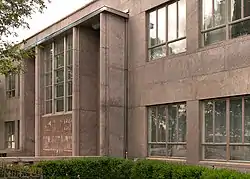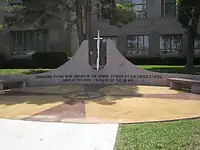Burnet County, Texas
Burnet County (/ˈbɜːrnɪt/ BUR-nit) is a county located on the Edwards Plateau in the U.S. state of Texas. As of the 2010 census, the population was 42,750.[1] Its county seat is Burnet.[2] The county was founded in 1852 and later organized in 1854.[3] It is named for David Gouverneur Burnet, the first (provisional) president of the Republic of Texas. The name of the county is pronounced with the emphasis or accent on the first syllable, just as is the case with its namesake.
Burnet County | |
|---|---|
 The Burnet County Courthouse in Burnet | |
 Location within the U.S. state of Texas | |
 Texas's location within the U.S. | |
| Coordinates: 30°47′N 98°11′W | |
| Country | |
| State | |
| Founded | 1854 |
| Named for | David Gouverneur Burnet |
| Seat | Burnet |
| Largest city | Marble Falls |
| Area | |
| • Total | 1,021 sq mi (2,640 km2) |
| • Land | 994 sq mi (2,570 km2) |
| • Water | 27 sq mi (70 km2) 2.6% |
| Population (2010) | |
| • Total | 42,750 |
| • Density | 43/sq mi (17/km2) |
| Time zone | UTC−6 (Central) |
| • Summer (DST) | UTC−5 (CDT) |
| Congressional district | 25th |
| Website | www |


History
Indigenous peoples inhabited the area as early as 4500 BC. Later known tribes in the area include Tonkawa, Lipan Apache, and Comanche.[4]
During the 1820s-1830s, Stephen F. Austin and Green DeWitt conducted surveying and Indian-fighting explorations.[4] In 1849, the United States established Fort Croghan,[5] and in 1848, the first settlers arrived in the county, Samuel Eli Holland, Logan Vandeveer, Peter Kerr, William Harrison Magill, Noah Smithwick, Captain Jesse B. Burnham, R. H. Hall, Adam Rankin "Stovepipe" Johnson, and Captain Christian Dorbandt.[6] In 1851, 20 Mormon families under the leadership of Lyman Wight establish a colony at Hamilton Creek, later to be known as Morman Mill.
In 1852, the Fourth Texas Legislature created Burnet County from Bell, Travis, and Williamson Counties.[4] The first post office was established at Hamilton in 1853.[4]
In 1860, 235 slaves were in Burnet County.[4] After the war, some former slaves left the county, but many stayed. A group of them settled on land in the eastern part of Oatmeal. In 1870, the black population of the county had increased to 358, keeping pace with the growth of the total number of residents; the number of blacks had fallen to 248 by 1880, however, and the number of new white residents was such that after 1890, blacks represented less than 3% of the total population. Some found work on farms and ranches, but by the turn of the century, many had moved into the Marble Falls area to work in town.
During 1882–1903, railroad tracks connected Burnet, Granite Mountain, Marble Falls, and Lampasas. Lake Victor and Bertram became shipping-point communities. Other communities lost population as the railroad offered employment.[4]
During the Great Depression, county farmers suffered financially, but found work with government-sponsored public-works projects. The Lower Colorado River Authority employed hundreds of people for the construction of the Hamilton (Buchanan) Dam and Roy B. Inks Dam.[4]
Geography
According to the U.S. Census Bureau, the county has a total area of 1,021 sq mi (2,640 km2), of which 994 sq mi (2,570 km2) are land and 27 sq mi (70 km2) (2.6%) are covered by water.[7]
Major highways
 U.S. Highway 183
U.S. Highway 183 U.S. Highway 281
U.S. Highway 281 State Highway 29
State Highway 29
Adjacent counties
- Lampasas County (north)
- Bell County (northeast)
- Williamson County (east)
- Travis County (southeast)
- Blanco County (south)
- Llano County (west)
- San Saba County (northwest)
National protected area
Demographics
| Historical population | |||
|---|---|---|---|
| Census | Pop. | %± | |
| 1860 | 2,487 | — | |
| 1870 | 3,688 | 48.3% | |
| 1880 | 6,855 | 85.9% | |
| 1890 | 10,747 | 56.8% | |
| 1900 | 10,528 | −2.0% | |
| 1910 | 10,755 | 2.2% | |
| 1920 | 9,499 | −11.7% | |
| 1930 | 10,355 | 9.0% | |
| 1940 | 10,771 | 4.0% | |
| 1950 | 10,356 | −3.9% | |
| 1960 | 9,265 | −10.5% | |
| 1970 | 11,420 | 23.3% | |
| 1980 | 17,803 | 55.9% | |
| 1990 | 22,677 | 27.4% | |
| 2000 | 34,147 | 50.6% | |
| 2010 | 42,750 | 25.2% | |
| 2019 (est.) | 48,155 | [8] | 12.6% |
| U.S. Decennial Census[9] 1850–2010[10] 2010–2014[1] | |||
As of the census[11] of 2000, 34,147 people, 13,133 households, and 9,665 families were residing in the county. The population density was 34 people/sq mi (13/km2). The 15,933 housing units averaged 16/sq mi (6/km2). The racial makeup of the county was 89.64% White, 1.52% African American, 0.68% Native American, 0.28% Asian, 6.30% from other races, and 1.58% from two or more races. About 14.77% of the population were Hispanic or Latino of any race.
Of the 13,133 households, 30.10% had children under the age of 18 living with them, 61.50% were married couples living together, 8.60% had a female householder with no husband present, and 26.40% were not families. About 22.50% of all households were made up of individuals, and 10.80% had someone living alone who was 65 years of age or older. The average household size was 2.53, and the average family size was 2.94.
In the county, the age distribution was 24.50% under 18, 7.00% from 18 to 24, 26.00% from 25 to 44, 24.50% from 45 to 64, and 17.90% who were 65 or older. The median age was 40 years. For every 100 females, there were 93.80 males. For every 100 females age 18 and over, there were 91.30 males.
The median income for a household in the county was $37,921, and for a family was $43,871. Males had a median income of $30,255 versus $20,908 for females. The per capita income for the county was $18,850. About 7.90% of families and 10.90% of the population were below the poverty line, including 14.50% of those under age 18 and 7.90% of those age 65 or over.
Communities
Cities
- Bertram
- Burnet (county seat)
- Cottonwood Shores
- Double Horn
- Granite Shoals
- Highland Haven
- Horseshoe Bay (mostly in Llano County)
- Marble Falls
- Meadowlakes
Unincorporated communities
- Briggs
- Fairland
- Gandy
- Joppa
- Lake Victor
- Mahomet
- Mormon Mill
- Naruna
- Oakalla
- Oatmeal
- Scobee
- Sherwood Shores
- Smithwick
- Spicewood
- Sudduth
- Watson
Notable people
- Adam R. "Stovepipe" Johnson, Confederate general and the 1887 founder of Marble Falls, despite being blinded during the war.
- Gerald Lyda (1923–2005), general contractor and cattle rancher, born and raised in Burnet County.
- Stephen McGee (born September 27, 1985), former American football quarterback. Played college football for Texas A&M. Drafted and played NFL football for the Dallas Cowboys.
- James Oakley, former County Commissioner (1998–2005) and County Judge (2015–2018)
- Logan Vandeveer, early Texas soldier, ranger, cattleman and civic leader. Vandeveer was a leader in presenting the petition to the legislature in 1852 to establish Burnet County and was instrumental in having the town of Burnet named the county seat.
- Al Witcher (born 1936), American football player
Politics
| Year | Republican | Democratic | Third parties |
|---|---|---|---|
| 2016 | 76.2% 14,638 | 19.8% 3,797 | 4.0% 769 |
| 2012 | 76.5% 12,843 | 21.9% 3,674 | 1.7% 279 |
| 2008 | 71.4% 12,059 | 27.3% 4,608 | 1.3% 226 |
| 2004 | 72.8% 11,456 | 26.3% 4,147 | 0.9% 139 |
| 2000 | 70.2% 9,286 | 26.9% 3,557 | 2.9% 389 |
| 1996 | 52.0% 5,744 | 37.3% 4,123 | 10.7% 1,182 |
| 1992 | 39.5% 4,272 | 33.7% 3,638 | 26.8% 2,897 |
| 1988 | 53.9% 5,120 | 45.7% 4,343 | 0.5% 45 |
| 1984 | 66.2% 5,895 | 33.5% 2,983 | 0.3% 29 |
| 1980 | 50.8% 4,033 | 46.8% 3,711 | 2.4% 189 |
| 1976 | 41.9% 2,777 | 57.5% 3,818 | 0.6% 41 |
| 1972 | 73.3% 3,438 | 26.2% 1,227 | 0.5% 23 |
| 1968 | 36.7% 1,459 | 47.2% 1,876 | 16.2% 643 |
| 1964 | 24.1% 821 | 75.8% 2,585 | 0.1% 4 |
| 1960 | 40.0% 1,189 | 59.5% 1,770 | 0.6% 17 |
| 1956 | 44.9% 1,163 | 54.9% 1,422 | 0.2% 5 |
| 1952 | 47.0% 1,270 | 52.9% 1,431 | 0.1% 2 |
| 1948 | 12.4% 287 | 84.1% 1,955 | 3.5% 82 |
| 1944 | 10.8% 228 | 80.4% 1,697 | 8.9% 187 |
| 1940 | 9.7% 233 | 90.3% 2,177 | 0.1% 2 |
| 1936 | 6.5% 111 | 93.3% 1,583 | 0.1% 2 |
| 1932 | 7.0% 144 | 92.9% 1,904 | 0.1% 2 |
| 1928 | 66.7% 936 | 33.3% 467 | 0.1% 1 |
| 1924 | 13.5% 277 | 83.7% 1,725 | 2.8% 58 |
| 1920 | 19.0% 241 | 62.6% 795 | 18.4% 234 |
| 1916 | 10.9% 115 | 86.3% 913 | 2.8% 30 |
| 1912 | 10.9% 85 | 79.7% 623 | 9.5% 74 |
See also
References
- "State & County QuickFacts". United States Census Bureau. Archived from the original on July 7, 2011. Retrieved December 8, 2013.
- "Find a County". National Association of Counties. Archived from the original on 2011-05-31. Retrieved 2011-06-07.
- "Texas: Individual County Chronologies". Texas Atlas of Historical County Boundaries. The Newberry Library. 2008. Retrieved May 20, 2015.
- Smyrl, Vivian Elizabeth (2010-06-12). "Burnet County, Texas". Handbook of Texas Online. Texas State Historical Association. Retrieved 29 November 2010.
- "Fort Croghan". Handbook of Texas Online. Texas State Historical Association. 2010-06-12. Retrieved 29 November 2010.
- Goble, Carole A (2009). "Fort Croghan and the First Settlers". Burnet (Images of America). Arcadia Publishing. pp. 9–30. ISBN 978-0-7385-7121-8.
- "2010 Census Gazetteer Files". United States Census Bureau. August 22, 2012. Retrieved April 19, 2015.
- "Population and Housing Unit Estimates". United States Census Bureau. May 24, 2020. Retrieved May 27, 2020.
- "U.S. Decennial Census". United States Census Bureau. Retrieved April 19, 2015.
- "Texas Almanac: Population History of Counties from 1850–2010" (PDF). Texas Almanac. Retrieved April 19, 2015.
- "U.S. Census website". United States Census Bureau. Retrieved 2011-05-14.
- Leip, David. "Dave Leip's Atlas of U.S. Presidential Elections". uselectionatlas.org. Retrieved 2018-07-19.
External links
| Wikimedia Commons has media related to Burnet County, Texas. |
